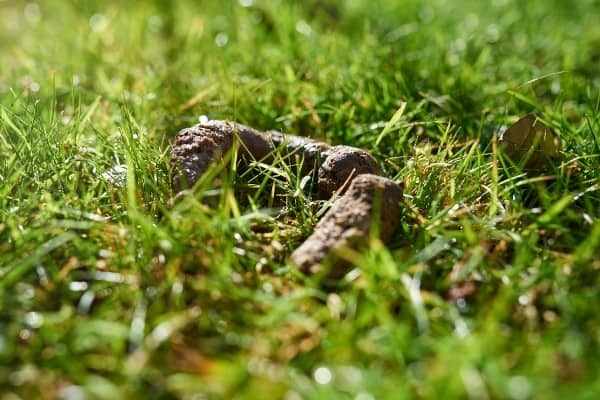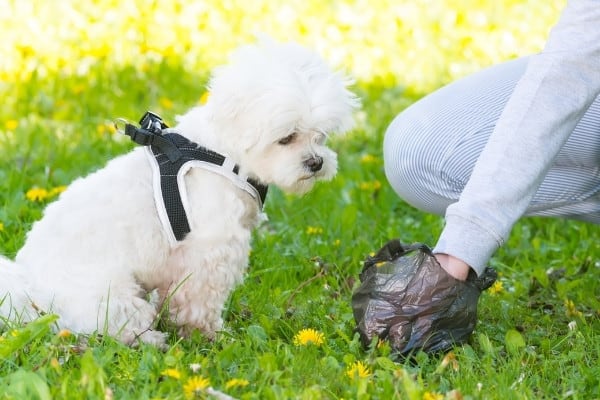
Not sure why you’re suddenly finding moldy dog poop in your yard? It’s not necessarily cause for concern.
Why does dog poop mold? Dog poop is a natural breeding ground for mold. It helps feces to decompose and break down into the soil. Mold is especially fond of humid areas, meaning pet owners from warm areas may already be familiar with this decomposition process.
Although molding dog poop is a natural process, molding feces is dangerous for dogs to consume.
When a dog digests molded dog poop, it may lead to dangerous symptoms such as vomiting, high fever, and tremors. In severe cases, too much consumption of molded dog poop may lead to a dog’s death.
To prevent serious health issues, it is crucial to know how to spot moldy dog poop and how to dispose of it safely.
Mold Growth on Dog Poop – What To Know
Moldy dog poop is more common than you think and can cause serious harm to animals when ingested. Mold on dog poop usually peeks out its head in the second or third week, but this may be sooner if an area is humid.
Not only is moldy dog poop full of harmful bacteria, but it is also a breeding ground for harmful organisms like whipworms, roundworms, and hookworms.
Below, we discuss why mold grows on dog poop, what this mold looks like, and why it’s dangerous. We will also tell you how to safely dispose of dog feces, and how often you should be doing it.
Why Mold Grows on Dog Poop
According to the World Health Organization, the mold found in dog feces contains mycotoxin, which can cause disease in people and animals.
Mycotoxin is a secondary metabolite (a substance that is necessary for metabolism), which is produced by organisms of fungi.
Furthermore, parasites such as whipworms, roundworms and hookworms will likely find their way into the dog poop, where they are known to shed their eggs.
Dog feces may also include cryptosporidium and giardia, parasites that cause diarrheal disease.
What Does Mold on Dog Poop Look Like?
You know when you’ve left a strawberry too long in the fridge and it gets a hairy, white covering? You will see the same hairy white appearance, which is mold, on dog poop that has started to decompose.
The hairy mold usually makes its appearance on dog feces within two to three weeks. This may be sooner, depending on how humid an area is.
In short, moldy dog poop is not a pretty picture! Not that poop is a pretty picture, but you know what we mean.
How Long Does It Take for Dog Poop To Mold?
Within two to three weeks, dog poop’s decomposition process starts, and mold will start to appear if the climate is humid or warm.
Although the decomposition period is a natural and necessary process, dog feces is at its most harmful during this stage.
Dog poop in its first decomposition phase carries 20 million harmful bacteria per gram — that’s a lot of harmful bacteria!
Due to this large amount of harmful bacteria, it is crucial to dispose of dog poop, as the harmful pathogens (bacteria that can cause disease) are harmful to people and animals passing by.
We discuss the best way to dispose of dog poop below.
Is Moldy Dog Poop Dangerous?
Yes, the mold found on dog poop (and any other surface for that matter) can cause respiratory harm to dogs. When ingested, this mold is likely to poison a dog.
Symptoms caused by ingested mold include vomiting, high fever, and tremors. If dogs digest a large amount of mold, this may, unfortunately, lead to their death.
What To Do If Your Dog Eats Mold
When you suspect that your dog has eaten moldy dog poop (or any other mold), it is highly advised to take him to the vet. A professional will evaluate the seriousness of the condition and prescribe antibacterial medicine as needed.
If you can’t immediately reach a vet, give your dog bland food to settle the stomach in the meantime. This may include cooked rice or chicken.
You can also give your dog yogurt, which should settle the stomach until you can reach a vet.

How To Prevent Moldy Dog Poop
The easiest way to prevent mold from growing on your dog’s poop is to dispose of it in a timely manner.
Where there is no dog poop, mold cannot grow. Below, we give a few helpful ways how you can safely dispose of dog poop.
Best Way To Dispose of Dog Poop
Picking up after your dog is certainly not the most pleasant activity, but it is necessary for the health of your family, your dog, and any other pets you have.
Sealed Bags
To prevent the poop from harming anyone, scoop it up with a plastic bag and dispose of it safely. As plastic is harmful to the environment, we recommend using biodegradable bags.
This is how I handle my dog Chachi’s backyard deposits.
- DOG POOP BAGS: Our durable poop bags are a dog-walking essential. They are extremely portable and...
- 100% LEAK-PROOF CONSTRUCTION: These dog poop bags are extra long, extra strong, and 100% leak-proof,...
Flushing
This is a simple and eco-friendly way of disposing of dog poop without leaving a mess. Unless your area has a water shortage, you can consider simply flushing the poop down the toilet.
Burying
If you have a yard with soil, this is the ideal place to dispose of your dog’s poop safely.
Remember not to bury it directly underneath a plant, not to use the same hole twice in one week (to allow the feces to decompose), and to bury it deep enough so that your dog doesn’t unearth it.
The Doggie Dooley Septic System
- Environmentally safe in-ground pet-waste disposal system
- For 2 large dogs or 4 small dogs; works like a miniature septic tank
For the most environmentally safe and eco-friendly solution to disposing of poop, make use of the Doggie Dooley Septic System.
This nifty device works like a miniature septic tank. It is made of galvanized steel and has (thankfully) a foot-operated lid. Plus, you can use it for two large dogs or four small dogs.
Related Questions:
How Often Should You Pick Up Dog Poop in Your Yard?
Owners with multiple dogs should pick up the poop in their yard at least once a day. If you only have one dog, you can pick it up once or twice a week.
Of course, if you have children who play outside often, you’ll want to be extra diligent in your pick-up routine and may want to scan the yardfor poop every time they head outdoors.
Will Vinegar Dissolve Dog Poop?
While vinegar will not magically make a pile of moldy dog poop disappear, it is an effective agent to use when cleaning indoor messes.
PetMD suggests mixing white vinegar and water 50/50 to spray an area where your dog has pooped indoors. This will neutralize the PH levels so that the stain doesn’t brown while drying.
This is especially helpful when your dog has diarrhea and has left poop stains across the house.
Scoop up as much of the mess as you can and allow the rest to dry overnight.
Then, mix equal parts water, vinegar and dishwashing soap to spray onto the mess. Allow to sit on the stain for a few minutes, then blotch as needed.
Another bonus? Vinegar kills germs! All the more reason to have some extra around the house.
Conclusion
Moldy dog poop is not uncommon, but it can cause illness and even death in your dog if ingested.
It is highly recommended to safely dispose of dog feces through methods such as burying it or the Doggie Dooley Septic System.
Sources:
https://www.petmd.com/dog/general-health/how-clean-dog-poop
https://dogleashpro.com/dog-care/common-dog-questions/does-dog-poop-decompose/
https://petloverguy.com/can-dog-poop-mold/
https://www.reddit.com/r/dogs/comments/aolsz1/help_any_tips_on_prevent_mold_build_up_in_dog/
Last update on 2024-04-24 at 12:41 / Affiliate links / Images from Amazon Product Advertising API






